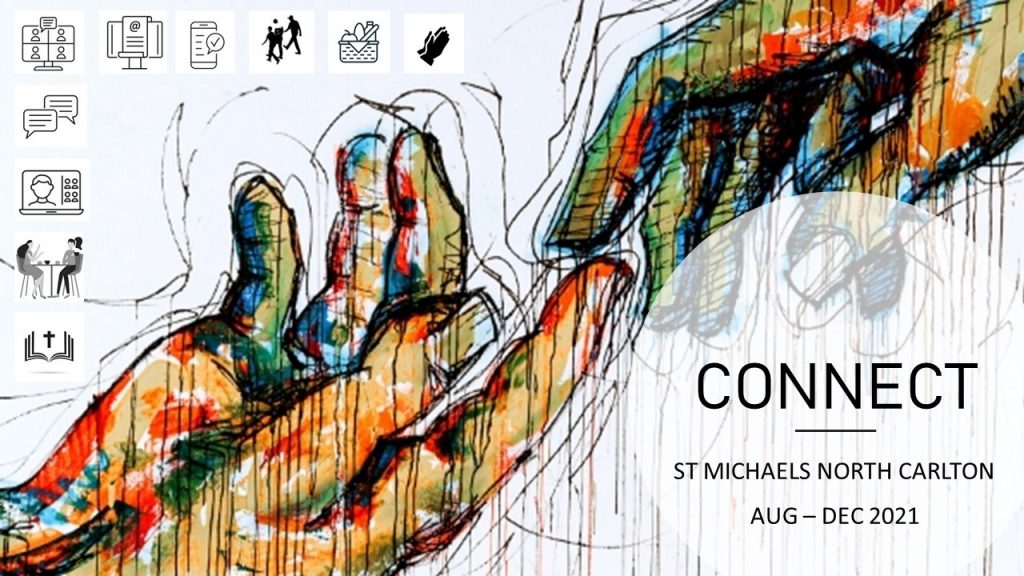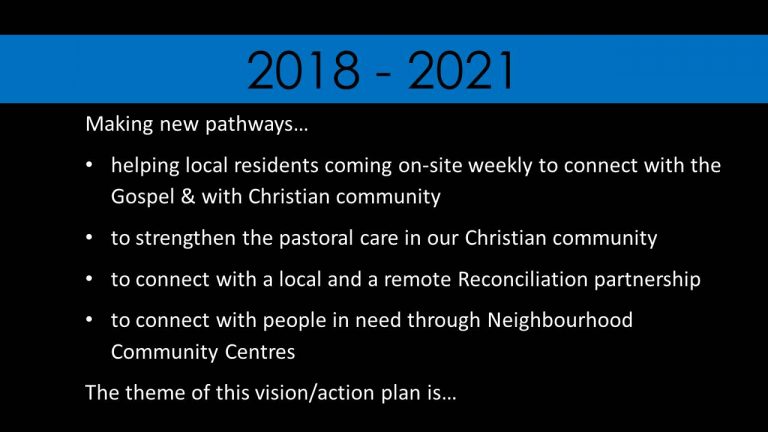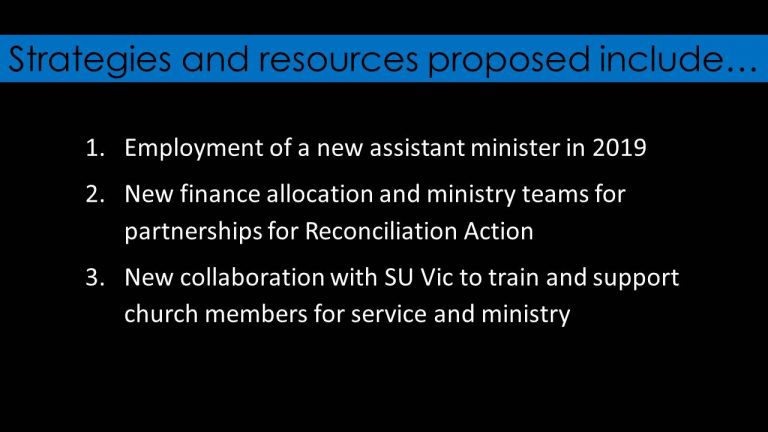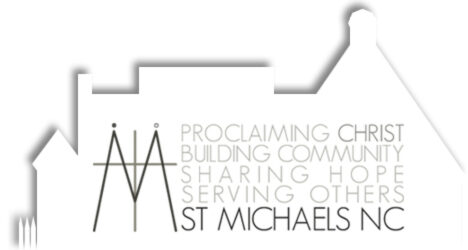Our mission and purpose as a local parish church is summed up well in four spheres of action:
Proclaiming Christ – Building Community – Sharing Hope – Serving Others
Upon these foundations, from time to time, our parish council sets out specific goals and strategies for a giving period to help guide our use of time, gifts, and resources to best make the Gospel of Jesus known in what we say and do. Below you will find the most recently published vision/action plans.
Page navigation
Latest update
Current vision/action plan
The journey so far
Latest Update
New Planning for immediate, medium-term, and long-term vision/action 2023
As we emerge from the recent restrictions of the global pandemic we begin a new course of prayerful conversations to establish new short-term goals and longer term aspirations for our parish ministries. Parish Council will receive reports in the first half of 2023 with a view to setting some broad goals and key questions to put to small focus groups in the second half of 2023. Progress on medium and long-term plans will be reported at the annual meeting in November 2023.
Short-term Vision/Action Plan Aug – Dec 2021

“Connect” is the theme of the new short-term vision/action plan at St Michaels North Carlton between August and December. As the graphic above illustrates, when lockdowns are prevalent and isolation and disconnection is the conversation on everyone’s lips, we recommend following the many encouragements in Scripture to intentionally create and sustain community. During this period, watch out for pop-up events of different kind, both online and face-to-face (when permitted) from time to time. We also encourage our church members to use every means available in these times of restrictions to connect with each other to care and build a stronger sense of community and faith.
More info to come soon. Check our “Events and Activities” page too.
Short-term Vision/Action Plan April – July 2021
“A time to heal…A time to plant”
The Book of Ecclesiastes chapter 3 poetically lists many seasons of human life. For April through June of 2021 we’ve discerned the need for a season of healing and a season for planting in our church and community.
Emerging from the global pandemic into a new pattern of living is not a simple matter. Many are experiencing grief in various forms from the events of the past 12 months and more.
Post-COVID19 living is also not a matter of merely returning to the way we were. Instead, we can take pause to learn from our journey and to seek God’s help to heal.
We might also dare to plant seeds, to facilitate new opportunities for relationships and ministry and see, under God, what new ways of being church might take root and grow.
Some new ministries ahead include: (dates TBA)
April 2021
- Reconfiguring church space to maximize seating for gathering safely
- Continuing live-streaming to serve keep people connected
- A musicians/singers day to pray, discuss and plan for a return to live music in church
- New “Jesus” study sessions on Zoom
- Creation Care sermon series, with practical help from our action group and from Common Grace
May 2021
- Partnership “launch” with Common Grace
- “A sense of place” – guided visits to local environments to explore God’s creation
- Common Grace workshop on reconciliation: “listening to the Statement of The Heart”
June 2021
- Seminars for responding to grief & loss
- Parents’ resource library to serve families in our wider community
- “Returning to country”, a ceremony from Common Grace to assist our return to in-person community
Current Vision/Action Plan
In the challenging context of the global coronavirus pandemic our prayerful and collaborative vision/action planning has led to the following important directions, strategies, and goals for the year ahead.
In The Book of Acts we see how the early church, and the apostles of Christ, had to be agile, meeting in a variety of ways and places, and changing course when the circumstances changed. Agility and innovation, faith and vision were necessary attributes in such times. Like them, we need to be open to the Spirit of God and navigate the rapidly changing world around us. We will stay true to God’s call, aligned with our diocesan partners in mission, and open to God’s wisdom. To be sure, though, we will undergo many changes in these unprecedented times, to adapt and innovate while keeping true to our foundations and ethos with the help of God.
Our new plans respond broadly to three biblical commissions:
- Make the Gospel known by word and deed (e.g. Matt. 28:20), and
- Care for God’s people (e.g. John 15:12)
- Love mercy and do justice (e.g. Micah 6:8)
KEY PRINCIPLES IN THIS VISION/ACTION PLANNING PERIOD
The following key principles are explained in full on our website. In summary:
- Our vision/action plans have short-term reviews built in.
- Church will be both in-person/and on-line in the future.
- Our on-line access points will include interest-oriented groups, activities and ministries.
- A refreshed commitment to Reconciliation will form part of our plans.
- The “gifts”, abilities and networks of our parishioners will influence our plans.
- We will use of our church property creatively while in-person use is limited.
- We will be proactive in communicating on-line with parishioners.
- We favour live on-line gatherings over on-demand recorded services and events.
- We will systematically make regular contact with parishioners during the pandemic.
- We will offer a wide range of small, significant communities to join.
- COVID-safe plans will be put in place when in-person gatherings, however limited, resume.
SHIFT FROM A SUNDAY-CENTRIC ON-LINE FOCUS TO MULTIPLE ENTRY POINTS
Our on-line presence as a church has been dominated by access to church on Sundays and augmented by contacts and information. This misrepresents the wide range of entry points and
access points to Christian community on offer at St Michael’s. This vision/action plan sets out to improve visibility and access on-line to a wider range of ministries. This will help us to improve our pastoral care and our outreach during the global pandemic.
In the pre-COVID world, St Michael’s Church benefitted greatly from its property’s physical visibility and architecture and the freedoms that allowed our parishioners to interact with and invite their friends to church services, events and activities. Our church site is prominent and attractive. The glass foyer is both symbolic and practical, offering a welcoming entry where anyone in the general public can look in and see and assess the church’s people, and information about the church’s life on Sundays and other days before choosing to enter.
In the current pandemic environment physical access to church life is highly restricted. This vision/action plan proposes significant changes to entry and access to our Christian community via on-line and virtual means. Like the glass door into the physical church property, these plans propose to make many new on-line “doorways” that are transparent through which people can “enter” and engage with the life of our church.
Some key changes are as follows:
- Website changes: Our very practical and effective website will soon feature seven (7) “glass doors” into the life of the church community. Parishioners and new enquirers alike will be able to navigate their way from the home page of the website quickly and easily into arenas of interest and affinities. Each “glass door” will allow entry into a variety of activities, groups and resources related to the title above it. The working titles above these seven “glass doors” include: The seven hubs proposed are:
- Advocacy and Action
- Groups and activities for justice, mercy and peace – such as reconciliation action, prevention of violence against women, climate action, refugee support (ASRC), women’s support in Africa (BMF), Overseas Aid & Relief (TEAR), Common Grace, and more
- Creatives
- Groups and classes for those whose gifts and professional work includes art, music, drama, craft, movies, sculpture, writing, and more
- Learning
- Parenting courses
- Book reviews and book swap
- Links to recommended webinars and conferences
- Christian education groups and resources e.g. Alpha, Ridley Certificate course, Zondervan MasterLectures, johndickson.org, and more
- Sermon and study resources in our library, via links, YouTube channel
- Wellness and Spirituality
- Resources (written and video) for wellbeing, spiritual growth
- Groups and activities for:
- prayer,
- mindfulness,
- contemplation,
- mental health, and more
- Community choir (via Zoom)
- Worship
- Direct links to live worship services via YouTube and Facebook on Sundays
- Links to YouTube channel resources for worship in the home, on-demand
- Community
- Pastoral small groups and bible study groups
- Prayer support group
- Contact details for church staff and leaders
- Playgroup
- Christmas events
- Concerts
- Book groups
- Walking group (when restrictions ease)
- What’s App groups
- Community choir
- Gospel missions Partners
- Church Missionary Society (CMS) link
- Ridley College preparing people for Gospel ministry
- Common Grace network
- Sports chaplaincy
- Advocacy and Action
- Social Media Changes: We will maximize the effectiveness of access to all the above information and activities via our social media channels and platforms, including: Google search, Google My Business, YouTube, Twitter, Instagram, Facebook, WhatsApp
- Subscribers and Followers – parishioners will be encouraged to express their “membership” on-line by becoming subscribers and followers on the abovementioned platforms. This helps the church’s administrators and pastors to keep track (without invading privacy) of who is regularly part of our community and to identify those who are new or enquiring. The following video explains how to do so: https://www.youtube.com/watch?v=aXGO1QAgZbM
- Curating our social media accounts – staff time will be directed to make changes that improve the effectiveness of our on-line presence and communication:
- A new “welcome to St Michael’s” video clip on our YouTube channel
- Playlists of worship and small group video resources on YouTube
- Watch parties via Facebook
- What’s App groups for connection via interests
AGILE STAFF & STRUCTURES
Parish Council has committed to maintain current levels of staffing for the 2020-2021 budget, with short-term reviews built in to assess the financial status at quarterly markers. In the immediate future, staff time and skills will be deployed with greater flexibility, with short-term reviews of tasks and goals to provide the agility needed to meet the ever-changing environment of this pandemic.
Paid staff:
- Steve Webster, Vicar (full time)
- Kim Messieh, Assistant Minister ASLM (part time)
- Catherine Ward, Children’s Ministry Assistant (part time)
- Emma Sugars, Office Assistant (part time)
Honorary Staff:
- Roslyn Loader, Missions Secretary ALM
- Hilary Toppin, Welcoming
- Greg Davies, Assisting Priest
- Chris Appleby, Assisting Priest
NEW PARTNERSHIPS IN MINISTRY
- Our Reconciliation Action Committee (RAC) has now helped us complete a 3 year commitment plan after it was launched by the Archbishop of Melbourne in November 2017. RAC has now recommended, and parish council has adopted a formal partnership with Common Grace (www.commongrace.org) which includes a financial contribution and involvement in a variety of engagements promoting reconciliation and justice for Aboriginal and Torres Strait Island peoples.
- Our Climate Action Group (CAG) which formed this year has aligned our church community informally with the activities of Australian Religious Response to Climate Change (ARRCC https://www.arrcc.org.au/). In addition, it has recommended a number of ways to improve the climate action credentials of our church by making changes consistent with climate change awareness. This includes a new project to install solar panels on our two properties and other climate-friendly behaviour changes.
PROPERTY AND RESOURCES
- Some works of restoration and repair on the church and vicarage sites will be undertaken during this period of COVID-restriction while the opportunity presents and as finances allow (with the assistance grants).
- A solar panel installation project is underway (with budget-neutral outcomes) to align with goals presented to parish council by our Climate Action Group.
Conclusion
As we learned in the recent sermon series from the Book of Esther, we can consider how God may have prepared us for times just like these. Though history’s ultimate outcomes are in God’s sovereign “hands”, we can be aware and faithful in our response to changes and challenges and ready to change and move where God leads.
[Mordecai said to Esther] “And who knows but that you have come to your royal position for such a time as this?” (Esther 4:14)
Far from being grounds for any kind of over-inflated sense of importance, The Book of Esther leads us to recognise God’s sovereignty, greatness and providence. Even when circumstances may look otherwise, we know that God is at work with love, grace and mercy. God’s Spirit will surely generate in us the faith, hope and love we need no matter what challenges we face.
With these truths in mind, the words of John the Elder continue as an inspiration for our times:
God showed how much he loved us by sending his one and only Son into the world so that we might have eternal life through him. This is real love—not that we loved God, but that he loved us and sent his Son as a sacrifice to take away our sins. (1 John 4:9-10 NLT)
The journey so far
In 2018, the people of St Michael’s Anglican Church North Carlton committed themselves to a new vision/action plan that prepared the way for a period of three years of growth and development of the church’s health and fruitfulness.
The key elements of that vision statement were:

Some of the new resources and strategies put to work to help see this vision/action plan realized included…

At almost the half-way point in this vision/action period, we have made progress in a number of areas, including…
- Establishing a new staff position- we have employed a new assistant minister (Kim Messieh) whose key focus is to engage with people who come to our church site for various activities during weekdays. Her work will help us to create new ministries that help such people connect with the life of the church in new and meaningful ways.
- Increased support and action for our reconciliation action activities- we have committed on-going financial support to our action group and begun several initiatives to increase our awareness of and participation in reconciliation activities and ministries.
- Appointment of a Student Minister and Pastoral Visitor in our staffing- In 2019, Stacey Slater has worked with us, involved in pastoral care and Sunday services. Also, The Rev’d Greg Davies has taken up a regular role of pastoral visiting among members of the congregation to assist the Vicar in that important work.
- Boosted our financial resources for the increased levels of staffing- Generous giving by members of the church in the lead up to this vision/action period to prepare the way to employing a full-time assistant minister saw an increase in our cash reserves enabling us to set aside approx. $30K to subsidise our employment expenses in 2019/20 and 2020/21 with a view to sustaining this new level of staffing for the long term by the end of 2021.
Next steps in the journey
As we stand at about the half-way mark of this current vision/action plan period, our next steps will be important to seeing real fruit produced from the fertile ground that has been prepared for future growth and change.
- After 4 months of observing and investigating the opportunities for ministry already present, our new assistant minister will report to the Parish Council in October 2019 and to the church members at the Annual Meeting with implications to role out over the coming months
- Based on step 1 above, new ministry teams and strategies will be prepared and trialled in 2020 to see new opportunities for change and growth to bear fruit as God enables us in our efforts. This is the key period to begin to uncover the “new pathways” we envisioned would be needed if we are to see growth in the number of people joining our community of faith in the coming years
- New initiatives in strengthening the faith and discipleship of our current church members will be introduced in 2020, especially in the area of small groups for learning, prayer and pastoral care
- New ways to communicate information about our many ministries, activities and resources will be developed and implemented in the coming year to help both our members and new people to find their fit in our community of faith
Getting “smaller” as we grow
Sometimes we miss a most significant fact in the so-called “great commission” Jesus gave as recorded in Matthew’s Gospel, chapter 28..
“19 Go therefore and make disciples of all nations, baptizing them in the name of the Father and of the Son and of the Holy Spirit, 20 and teaching them to obey everything that I have commanded you. And remember, I am with you always, to the end of the age.” Matthew 28:19,20
It’s easy to be distracted in this passage by the extraordinary scope of the vision (into all the world). We miss the significant fact that this vision was cast before a tiny band of followers. The scope was huge; but the means was minute! Jesus promised something big, through small group of people.
In his book, The Forgotten Ways, Alan Hirsch writes:
“Ever since the mission and ministry of Jesus, God has never stopped calling for a movement of “Little Jesuses” to follow him into the world… Given the situation of the Church in the West, much will now depend on whether we are willing to break out of a stifling herd instinct and find God again in the context of the advancing God’s Kingdom.”
There is perhaps no better time than in this period of history, when the institutional church is looked upon with suspicion or as irrelevant by so many, that we should see the best version of church as small communities of faith sharing love and hope.
When it comes to the hope we share, even the core tenets believed by disciples today could do with some simplifying and clarifying as we communicate with the people living around us. It’s possible to sum up what Jesus taught his own disciples to do around these 4 axes…
- Love God
- Love one another (and people will then know you are disciples of Jesus)
- Love others (just as you love yourselves)
- Help others to become followers of Jesus too.
Of course, we need not ignore the more complex and sophisticated teachings of the Apostles, and subsequently of Christian scholars down the years, but if we strip back the layers we may make plain sense to our neighbours.
What it looks like to be a “disciple” and what it means to “make” disciples in different communities will differ as it has in times and places past. It is wise to listen to the communities in which we are placed to serve and consider how best to make the love of God known in a way best suited to the context we are given.
As we share hope and love in our prayers, our care, and our service to others, we hope and pray that many will recognise God’s grace and love in action, as much as in our message.
Jesus’ method of making disciples
Jesus gathered a small group around him to commission them as the foundation of many similar bands of people who share the liberating and life-giving mercy and love of God in the world. But what was his method of making disciples?
In Mark chapter 3 we see the original terms and conditions of being a follower who is sent (an “apostle”)…
“And (Jesus) appointed twelve, whom he also named apostles, to be with him, and to be sent out…” Mark 3:14
The late Dallas Willard, a prolific writer on matters of discipleship, defined it this way… discipleship is “learning from Jesus how to live like Jesus.”
By being with Jesus, those first followers learned from Jesus how to think, act, to exercise faith and to live with a new vision of God and of life. They were invited to imitate him, in this sense, and then called to invite others to imitate them as followers.
While the context is different, it is hard to argue away the point that the practice can be similar today, with the help of the Holy Spirit. As people spend time with us in small communities of faith, we hope that they too will learn what it means to follow Jesus and put their trust in God, through Him.
Up In Out – 3 dimensions of church
 Mike Breen, author of Building a Discipling Culture and founder of 3DMpublishing [1] offers a simple and helpful diagnostic tool to help churches think simply and clearly about the vision of the church they wish to be in the future.
Mike Breen, author of Building a Discipling Culture and founder of 3DMpublishing [1] offers a simple and helpful diagnostic tool to help churches think simply and clearly about the vision of the church they wish to be in the future.
There are three key dimensions we witness in the Gospels of Jesus’ own life and mission and these become, for the church, guiding ideals for a church’s health and effectiveness.
Dimension 1: Up
Jesus demonstrated time and time again what it meant to exercise faith in and have a spiritual relationship His Heavenly Father. Many times, we read about Jesus praying – meditating on God’s Word, listening in quiet places, speaking in fervent prayer and praise. He had his own personal methods of engagement with God the Father, but also took part in informal gatherings in households, and in formal gatherings in synagogues and the temple. In The Book of Acts we then read how the apostles and followers in the early church doing the same things as regular practices.
Dimension 2: In
Jesus spent time very intentionally with his small group. He invested in a limited number of people in order that they would have a greater understanding and impact and he showed them a model for sharing hope with others. He let them in and took them with him. They knew one another, served one another, and loved one another. They did life together and served one another in a small and committed community. We see that this kind of reproduction of disciples of Jesus by imitation is later implied, sometimes explicit, in the teaching of the Apostle Paul.
Dimension 3: Out
Jesus also met needs he saw in the world around him as he went out to spread His good news about God. He served others with the God’s love, grace, and power. The Gospels show him taking his disciples with him as he did so and even commissioning them to do the same. He healed the sick, touched the unclean and outcast, fed the hungry, and opened blind eyes and deaf ears. He envisioned a new world, inviting people to turn from their old ways toward a new life promised by God to all who trust him. In The book of Acts the followers of Jesus are often depicted as doing things Jesus had been doing. They learned from Jesus how to reach out and serve others, even complete strangers beyond their communities, in God’s name. And they passed it on.
Up-In–and-Out was the way Jesus lived with his disciples and as followers of Jesus, so it’s fitting for us to look to the future of our church through these three lenses – Up, In, Out, and evaluate our own practices and plan ahead to be more true to our purpose and more fruitful in our life together.
Questions for consideration
Consider the Up – In – Out dimensions of discipleship using the following questions…
1) Most followers of Jesus feel more suited to one or two of the dimensions of the triangle, rather than at all three. What about you? Where are your strength areas? Why do you think that is?
2) What about our church? What evidence do you see of healthy and effective life-signs in each of the three dimensions – Up, In, and Out? Where are we strong? Where is there room for improvement?
3) What suggestions do you have for strengthening our church’s life and health in any of the three dimensions/
Please submit your feedback via email to office@stmichaelsnc.org.au, or make a time to meet with the vicar.
[1] https://www.3dmpublishing.com/mike-breen
Questions?
Steve Webster – vicar@stmichaelsnc.org.au
Emma Sugars – office@stmichaelsnc.org.au

